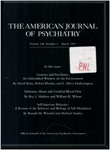Dopamine blockade and clinical response: evidence for two biological subgroups of schizophrenia
Abstract
Because CNS neuroleptic concentration cannot be directly measured in patients, the relation between clinical response and extent of dopamine receptor blockade is unknown. This relationship is critical in ascertaining whether nonresponse to neuroleptics is the result merely of inadequate CNS drug levels or of more basic biological differences in pathophysiology. Using [18F]N-methylspiroperidol and positron emission tomography, the authors assessed dopamine receptor occupancy in 10 schizophrenic patients before and after treatment with haloperidol. Responders and nonresponders had virtually identical indices of [18F]N-methylspiroperidol uptake after treatment, indicating that failure to respond clinically was not a function of neuroleptic uptake or binding in the CNS.
Access content
To read the fulltext, please use one of the options below to sign in or purchase access.- Personal login
- Institutional Login
- Sign in via OpenAthens
- Register for access
-
Please login/register if you wish to pair your device and check access availability.
Not a subscriber?
PsychiatryOnline subscription options offer access to the DSM-5 library, books, journals, CME, and patient resources. This all-in-one virtual library provides psychiatrists and mental health professionals with key resources for diagnosis, treatment, research, and professional development.
Need more help? PsychiatryOnline Customer Service may be reached by emailing [email protected] or by calling 800-368-5777 (in the U.S.) or 703-907-7322 (outside the U.S.).



